Potatoes require different amounts of moisture at different periods of development. The watering regime depends on the growing region and the presence of moisture in the soil. In areas of normal and high humidity, potatoes are not irrigated, and in arid regions the crop is grown only with irrigation.
|
Potatoes have the highest moisture requirement during budding and flowering. |
| Content:
|
When and how to water potatoes
Potatoes need the main amount of moisture during budding and flowering. In case of severe drought, watering is required even after flowering. It is important that they are carried out on time. Improper distribution of moisture leads to severe crop failure.
Watering is carried out:
- in the absence of precipitation during the period of budding and flowering;
- during drought and extreme heat for more than 14 days, regardless of the development phase;
- during short summer showers, when the soil does not get wet;
- In arid regions, potatoes are grown only on irrigated lands.
With a long absence of precipitation or watering, potatoes begin to form new tubers or grow tubers. As a result, it turns out to be very small, suitable only for cooking “in its uniform”.
Dependence of crop development on soil moisture
During the germination period crops, low soil moisture promotes the formation of a powerful root system that penetrates to a depth of 20-25 cm.
With high humidity during this period, a superficial root system is formed. In this case, it may be damaged during hilling, in addition, nutrients are absorbed much worse. High humidity also leads to the potatoes getting wet, the tubers suffocate in the soil from lack of oxygen, and some of them do not sprout at all.
Budding and flowering. At this time, potatoes have a maximum need for moisture. In its absence, very small tubers are formed. This cannot be corrected in the future either by watering or fertilizing.
The tops begin to wilt. Low humidity promotes the formation of strong skins and accelerates the ripening of tubers.
Excess moisture leads to secondary growth of tubers. The potatoes turn out lumpy, with growths and very watery. If there is severe waterlogging, part of the crop rots in the ground.
Number of waterings per season
The amount of watering depends on weather conditions. In southern arid regions, potatoes are watered 3-5 times:
- during the budding period;
- before the end of flowering;
- 15-20 days after flowering.
In regions with sufficient rainfall, water only when there has been no rain for more than 14 days. During prolonged intense heat (temperature more than 30°C), potatoes are watered every 7 days.
On light soils, irrigation is carried out more often, on heavy soils - less often. The soil should be soaked to a depth of 20-25 cm. To determine whether moisture is required or not, a peg is stuck into the boletus to a depth of 25 cm. If there is soil stuck to it, which rolls into lumps in your hands, then there is enough moisture. If the soil does not roll into lumps, it needs to be watered.
Both severe drought and waterlogging are harmful to potatoes. In both cases, secondary growth of tubers begins. During drought, new stolons and “babies” appear on already formed tubers. When overwatered, the tubers turn out ugly, lumpy and watery.
Methods of watering crops
The choice of method depends on the area of the plot and the region where potatoes are grown, as well as on the capabilities of the summer resident.
Watering methods.
- Sprinkling.
- Drip irrigation.
- Watering between rows.
- Manual watering.
Sprinkling
A very effective way to irrigate a potato plot. Sprinkling is artificially created rain, in which the soil is soaked to the required depth.
The quality of watering depends on the power of the rain and the size of the drops. The intensity of sprinkling should not be greater than the rate of moisture absorption by the soil. Moderate intensity rain with small drops is optimal. It is desirable that the sprayer has holes with a diameter of 1-1.5 mm.
Increasing droplet size and rain intensity can cause tops to become pinched and damaged. Too much sprinkling leads to the formation of a soil crust, the appearance of puddles in the rows and shallow wetting of the soil.
The method is used until the rows are completely closed during budding and the beginning of flowering. After the tops close, the effectiveness of sprinkling decreases. A significant part of the moisture remains on the tops and only a small amount reaches the soil, without wetting it to the required depth.
|
Sprinkling is carried out in the morning or evening, in cloudy weather - at any time. |
It is undesirable to carry out sprinkling during strong winds, since part of the rain is blown away, uneven wetting of the plot occurs - somewhere there is more water, and it collects in puddles, and somewhere the ground is not wet enough.
Drip irrigation
Another effective way to irrigate potatoes. It is very convenient to use it after closing the tops.
|
For drip irrigation, either a special system is installed or a barrel with pipes and hoses is used. |
Advantages of drip irrigation.
- Water goes directly to the roots; a crust does not form on the soil.
- There are no puddles between the rows.
- A normal microclimate is maintained inside the potato plot. Humidity in closed rows does not increase, as a result, the risk of diseases, late blight in the first place, is reduced.
- The entire plot is moistened evenly, there are no differences in humidity.
- Can be done at any time and in any weather.
- It is very convenient to apply fertilizers at the same time as watering.
The main disadvantage of drip irrigation is the clogging of the holes in the irrigation hoses with particles of soil. Due to the slow flow of water, blockages may not be detected immediately. As a result, some bush remains insufficiently moistened.
If the potato has formed a shallow root system, then during drought the roots can grow into the holes of the irrigation hoses in search of moisture. Therefore, it is necessary to check the working condition of the hoses more often.
Watering the rows
Used in regions with sufficient moisture, with a long absence of precipitation.
Use a hose that is placed between the rows. Water flows freely along the entire length of the row spacing. At the beginning and end of the row spacing, soil is added to prevent water from flowing beyond its boundaries.
|
After such watering, the soil becomes compacted, a soil crust appears and the crop must be loosened or hilled. |
With this method, the row spacing and the lower part of the boletus are soaked. If a superficial root system has formed, then the irrigation rate increases; it is necessary that there are puddles between the rows.
In addition, a lot of water evaporates, and the rest goes into the lower layers of the soil and becomes inaccessible to plants. Watering between rows is the worst way to water potatoes.
Manual method
This is the most labor-intensive method, but it is more efficient than watering with a hose. It can be carried out only until the rows close.
Each plant requires 3-4 liters of water for normal growth during budding and flowering. It is advisable to water the potatoes from a watering can and not from a hose.When using a hose, water flows down, forming puddles and not moistening the boletus itself; also, with strong pressure, the boletus is washed away, stolons and tubers end up on the surface.
|
The water temperature should not be lower than the soil temperature. |
Watering from a watering can is much more effective; it is advisable to put a divider on it. Water the potatoes at the root, directing the water to the center of the bush. With a watering can, quickly pass along the boletus 3-4 times until the soil is completely moistened. It is not recommended to pour the entire irrigation rate under one bush at once, since a large amount of water rolls down between the rows, forming puddles, and the boletus itself is poorly soaked. You need to water so that all the water is immediately absorbed into the soil.
Features of watering early varieties
For early potatoes, pour 2 liters of water under each bush. Unlike middle and late potatoes, early varieties consume water very intensively, but the need for it is less.
Maximum water consumption occurs during the period of budding and flowering. At this time, in the absence of precipitation, early potatoes are watered every 7-10 days. Carry out at least 2 waterings. Then the need for water decreases and the next watering is carried out only if there is no precipitation for more than 8-10 days.
Early potatoes are watered no more than 3 times.
Do not miss:
Hilling up potatoes
Hilling is carried out 2-3 days after watering. Its main goal is to destroy the soil crust and stimulate the formation of new roots. After the rows are closed, hilling is not possible.
|
Usually they hill up bushes by raking earth towards them, but you can hill them up by covering 2-3 stems in a bush with 2/3 of the soil. This stimulates the formation of additional tubers. |
Hilling retains soil moisture, preventing the soil from drying out, improves its heating and the supply of oxygen to the roots and tubers.
Conclusion
Potatoes are moderately demanding of water and do not need to be watered in rainy summers. But in dry summers, as well as in regions with hot climates, watering is required. Sudden changes in humidity have a negative effect on the harvest.
For example, in the summer of 2010 there was a bad harvest, and the tubers themselves were very small because there were heavy rains in June and the crop experienced severe waterlogging. Then the heat set in above 30°C with very hot nights and the plants experienced a lack of moisture. As a result, they planted potatoes and harvested “peas.”
Don't forget to read:
A productive and easy way to grow potatoes:
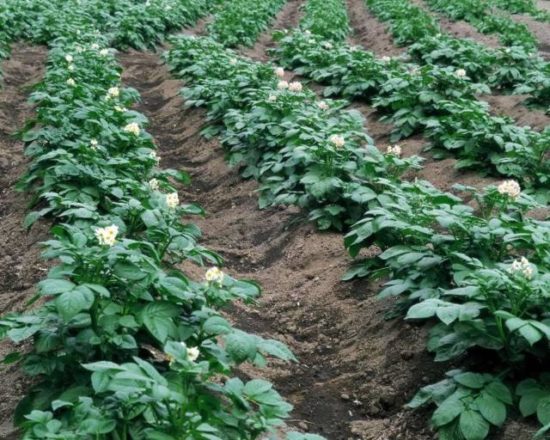


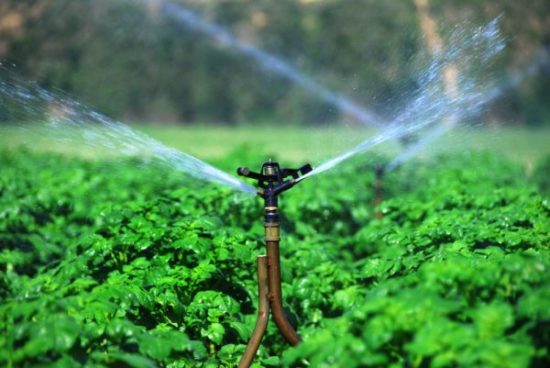
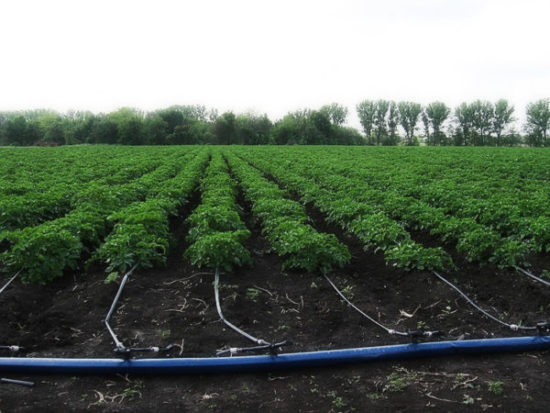

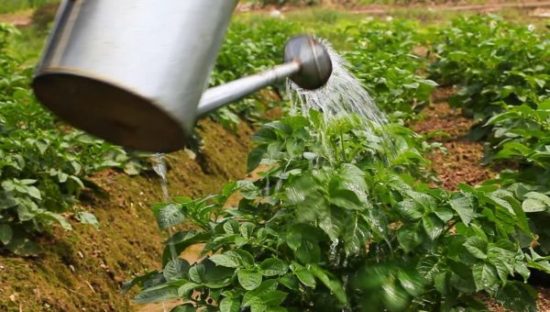
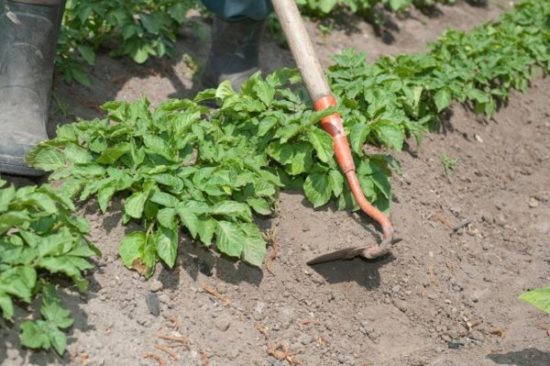


 (3 ratings, average: 3,67 out of 5)
(3 ratings, average: 3,67 out of 5) CUCUMBERS NEVER GET SICK, I'VE BEEN USING ONLY THIS FOR 40 YEARS! I SHARE A SECRET WITH YOU, CUCUMBERS ARE LIKE THE PICTURE!
CUCUMBERS NEVER GET SICK, I'VE BEEN USING ONLY THIS FOR 40 YEARS! I SHARE A SECRET WITH YOU, CUCUMBERS ARE LIKE THE PICTURE! You can dig a bucket of potatoes from each bush. Do you think these are fairy tales? Watch the video
You can dig a bucket of potatoes from each bush. Do you think these are fairy tales? Watch the video
 How our fellow gardeners work in Korea. There is a lot to learn and just fun to watch.
How our fellow gardeners work in Korea. There is a lot to learn and just fun to watch. Eye trainer. The author claims that with daily viewing, vision is restored. They don't charge money for views.
Eye trainer. The author claims that with daily viewing, vision is restored. They don't charge money for views. A 3-ingredient cake recipe in 30 minutes is better than Napoleon. Simple and very tasty.
A 3-ingredient cake recipe in 30 minutes is better than Napoleon. Simple and very tasty. Therapeutic exercises for cervical osteochondrosis. A complete set of exercises.
Therapeutic exercises for cervical osteochondrosis. A complete set of exercises. Which indoor plants match your zodiac sign?
Which indoor plants match your zodiac sign? What about them? Excursion to German dachas.
What about them? Excursion to German dachas.